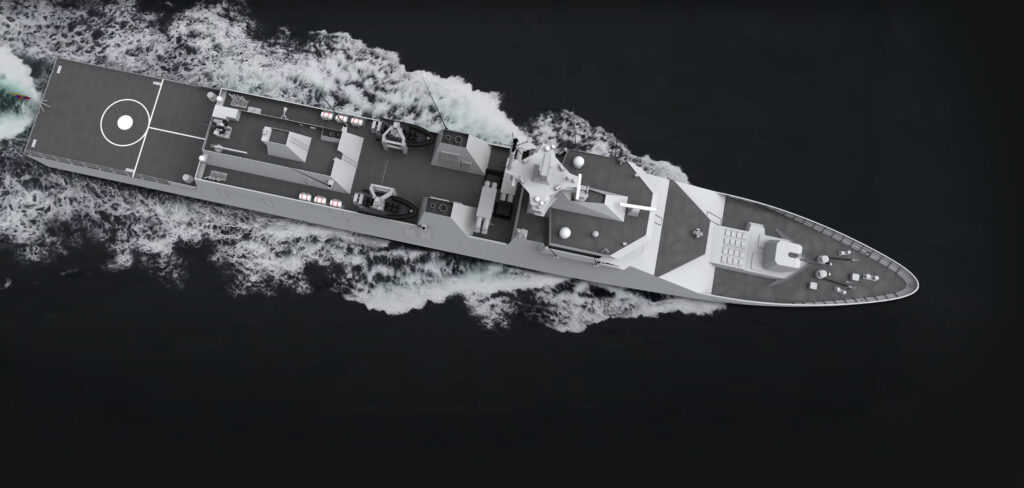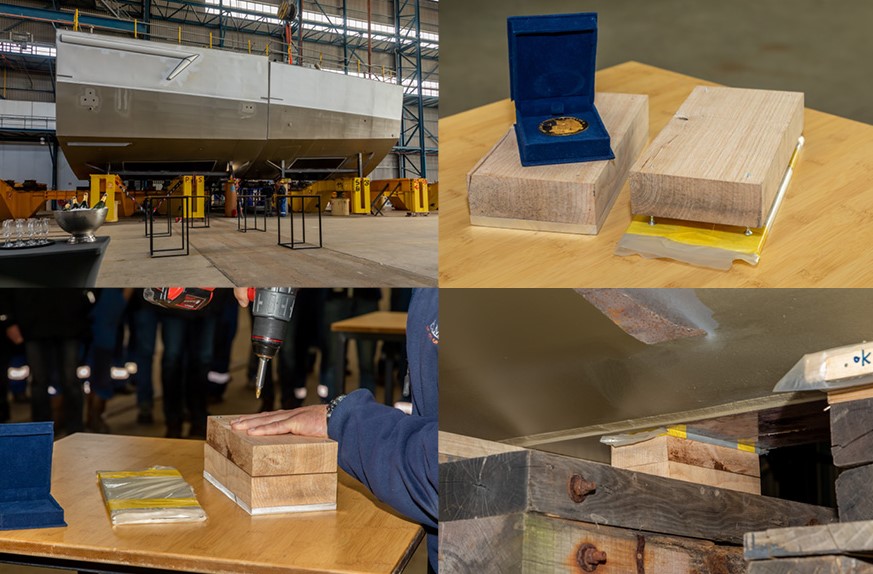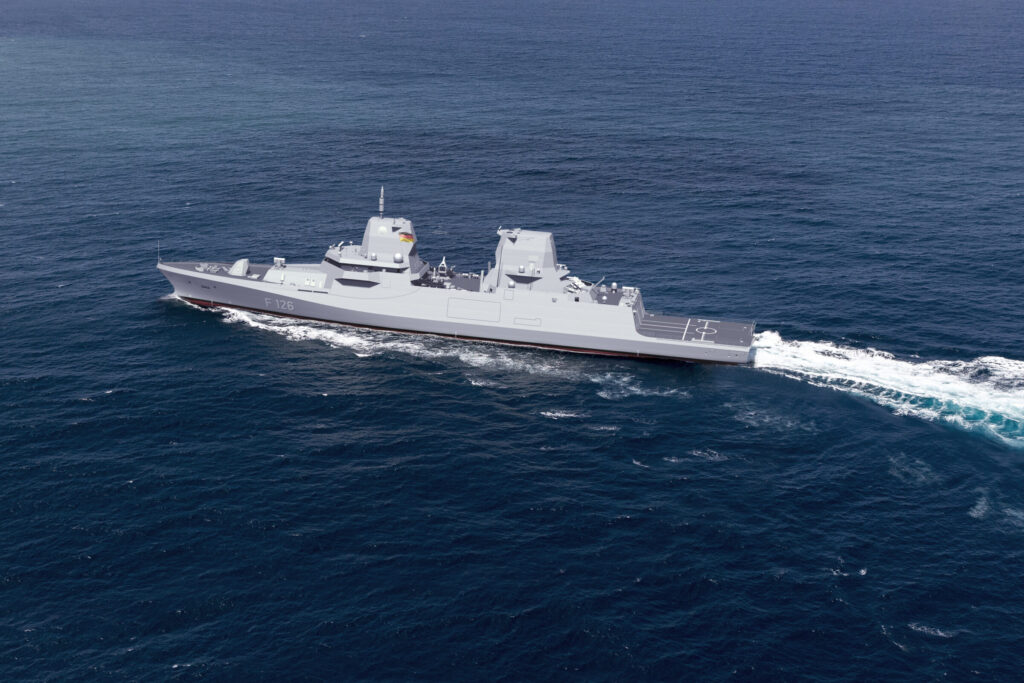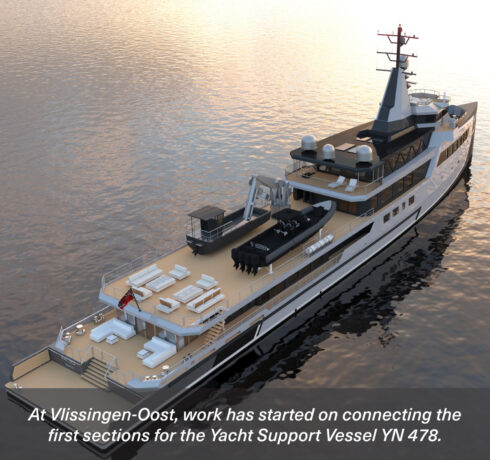The F126 project ends a busy and successful year with a new contract, the Colombia project has passed its first milestone and the Yacht Support Vessel YN 478 is starting to take shape at Vlissingen-Oost.
Colombia project in full swing: first deadline met
Following the signing of the design contract with COTECMAR, the Colombian Navy’s naval shipyard, the project is off to a swift start. The first package of design documents was delivered to the client in November.
Damen Naval signed a design contract with COTECMAR in October for a design study in which Colombia is looking at a new generation of frigates. These Plataforma Estratégica de Superficie (PES) will be the replacement for the Almirante Padilla class frigates.
 Damen Naval has started the second phase of the design study.
Damen Naval has started the second phase of the design study.
The design study was divided into three delivery stages consisting of a total of about 200 design documents. On 23 November, the first package of reference ship documents was handed over to the client. The design is based on the SIGMA 10514.
“We are currently further adapting the design of the reference frigate based on the requirements of the end user: the Colombian Navy,” says Simon Delva, Engineer Products and Proposals (P&P) at Damen Naval. “We are doing this together and in close contact with them and the shipyard COTECMAR. The purpose of the whole design study is to make sure we are all on the same wavelength.”
Meanwhile, colleagues from P&P have started the second phase in the project. “We are now developing the project-specific information: drawings, diagrams and calculations,” Simon explains. In summer 2023, the complete package, consisting of design documents and a detailed quotation, will be handed over to the client.
YN 478 is taking shape at Vlissingen-Oost
The YN 478 hull construction project at Vlissingen-Oost has seen significant progress since the previous ‘Project Update’. On 3 November, the teams from Damen Yachting and Vlissingen-Oost organised a coin ceremony, during which the vessel’s future owner placed a coin under the keel. In terms of construction, the most visible sign of progress is the number of hull sections in Hall 2. These sections have been fabricated in Hall 1, then painted in the painting shed, before going to Hall 2 for assembly and outfitting. As such, Hall 2 currently contains three sections.
 During the coin ceremony, the future owner of the Yacht Support Vessel placed a coin under the keel.
During the coin ceremony, the future owner of the Yacht Support Vessel placed a coin under the keel.
The next step, says the project’s Production Coordinator Stan Haag, is to start connecting the sections. “The first coupling has already taken place; two sections are brought together and, under inspection from the classification society, are welded together.” Another key step in the construction process is the installation of large equipment. “When you couple two sections, this closes off certain spaces. Therefore, we have to install any large equipment before coupling. For example, we have already installed a water maker and several components of the firefighting system,” adds Stan.
With the first two sections coupled, the hull of the ship has started to take shape. “Together with Damen Yachting, we are focusing on finishing the central corridor and the foreship of the hull as quickly as possible. The central corridor is the backbone of this ship, containing a lot of piping and equipment. As soon as it is finished, we can start pulling cables. And with the foreship in place, we can get ready for interior construction.”
The YN 478 project has experienced some delays due to changes in engineering plans. “We are working closely with the team from Damen Yachting, trying to make smart decisions with them to cope with these changes as well as possible,” Stan concludes.
F126 project starts with detailed engineering
Damen Naval’s F126 project – building four frigates for the German Navy – rounds off 2022 with a wide selection of news. In terms of engineering, the most significant step has been the beginning of the detailed engineering phase, which is being carried out by Marine Engineering Galaţi (MEGA) based in Galaţi, Romania. There are currently 45 MEGA engineers and five support staff working on the F126 project, but this will increase to around 100 over the coming year. This team will be working out of MEGA’s newly expanded offices, which now have the same levels of security as the F126 team based in Vlissingen (read more about MEGA’s new offices here). Furthermore, the MEGA team has received the necessary project-specific training in order to carry out their work effectively.
 Milestone: Marine Engineering Galaţi (MEGA) in Romania has started detailed engineering for the F126 frigates.
Milestone: Marine Engineering Galaţi (MEGA) in Romania has started detailed engineering for the F126 frigates.
Continuing with the subject of training, the dedicated F126 Academy has expanded its range of training courses for team members. These courses are diverse in subject matter, ranging from ‘An Introduction of Combat Systems’ to ‘Time Management’. Moreover, the courses are flexible in nature; some being available as independent ‘self-training’ sessions, and other courses being given in a more traditional group situation. Certain training programmes are also given online; the notable example for this is the 3DX software training given to the detailed engineering team in Romania.
The list of suppliers joining the F126 team continues to grow, with German technology group Rheinmetall being the latest to secure a contract with Damen Naval. Rheinmetall will be supplying eight of its next generation MLG27-4.0 defence systems; these will serve as secondary guns for the F126 frigates. Each frigate will be equipped with two of these 27mm gunnery defence systems, positioned at port and starboard. In combination with other systems, the MLG27-4.0 will contribute to a full 360-degree defensive coverage.
 Rheinmetall is supplying eight next-generation MLG27-4.0 defence systems that will serve as secondary guns for the F126 frigates.
Rheinmetall is supplying eight next-generation MLG27-4.0 defence systems that will serve as secondary guns for the F126 frigates.
Another notable newcomer to the F126 project is Sander Boost, who joins the project board that already consists of Frank Verhelst, Bertram Liebler and Magiel Venema. “We are very pleased that Sander is joining the F126 team. Within Damen Naval, he is probably most well-known for his coordination of the recent LST 100 project completed for the Nigerian Navy. For the F126 project, his focus will be on leading the Engineering and Purchasing activities of the project,” says F126 Project Director Frank Verhelst.
On a sociable note, the F126 project management organised a ‘Dinner for Stakeholders’ on 15 November. “This was the first time that we have got together with all the main parties – including our customer, subcontractors and suppliers – in such a sociable setting,” notes Frank. “Throughout the duration of the project, our aim is to create a team feeling. An evening like this certainly helps with that; building the relationships with these key stakeholders will facilitate the project’s progress in the years ahead.”
And to end the year well, an ‘Extended Project Management Meeting’ was held in Middelburg on the 13 and 14 December. During this meeting the status of the complete project was presented and discussed, but also attention was given to the social aspects of the project, with a dinner and a museum visit.

